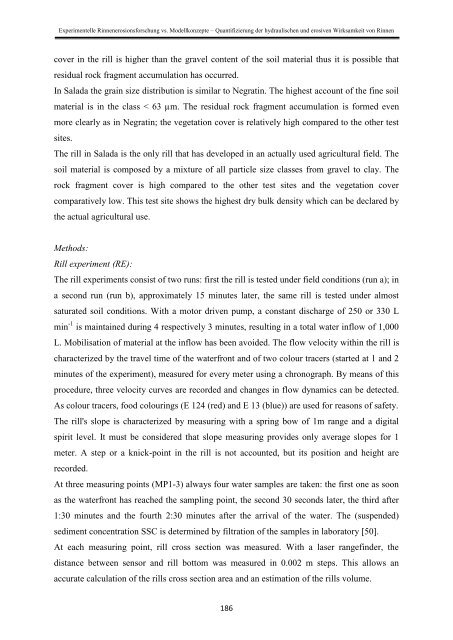Stefan Wirtz Vom Fachbereich VI (Geographie/Geowissenschaften ...
Stefan Wirtz Vom Fachbereich VI (Geographie/Geowissenschaften ...
Stefan Wirtz Vom Fachbereich VI (Geographie/Geowissenschaften ...
Create successful ePaper yourself
Turn your PDF publications into a flip-book with our unique Google optimized e-Paper software.
Experimentelle Rinnenerosionsforschung vs. Modellkonzepte – Quantifizierung der hydraulischen und erosiven Wirksamkeit von Rinnen<br />
cover in the rill is higher than the gravel content of the soil material thus it is possible that<br />
residual rock fragment accumulation has occurred.<br />
In Salada the grain size distribution is similar to Negratin. The highest account of the fine soil<br />
material is in the class < 63 µm. The residual rock fragment accumulation is formed even<br />
more clearly as in Negratin; the vegetation cover is relatively high compared to the other test<br />
sites.<br />
The rill in Salada is the only rill that has developed in an actually used agricultural field. The<br />
soil material is composed by a mixture of all particle size classes from gravel to clay. The<br />
rock fragment cover is high compared to the other test sites and the vegetation cover<br />
comparatively low. This test site shows the highest dry bulk density which can be declared by<br />
the actual agricultural use.<br />
Methods:<br />
Rill experiment (RE):<br />
The rill experiments consist of two runs: first the rill is tested under field conditions (run a); in<br />
a second run (run b), approximately 15 minutes later, the same rill is tested under almost<br />
saturated soil conditions. With a motor driven pump, a constant discharge of 250 or 330 L<br />
min -1 is maintained during 4 respectively 3 minutes, resulting in a total water inflow of 1,000<br />
L. Mobilisation of material at the inflow has been avoided. The flow velocity within the rill is<br />
characterized by the travel time of the waterfront and of two colour tracers (started at 1 and 2<br />
minutes of the experiment), measured for every meter using a chronograph. By means of this<br />
procedure, three velocity curves are recorded and changes in flow dynamics can be detected.<br />
As colour tracers, food colourings (E 124 (red) and E 13 (blue)) are used for reasons of safety.<br />
The rill's slope is characterized by measuring with a spring bow of 1m range and a digital<br />
spirit level. It must be considered that slope measuring provides only average slopes for 1<br />
meter. A step or a knick-point in the rill is not accounted, but its position and height are<br />
recorded.<br />
At three measuring points (MP1-3) always four water samples are taken: the first one as soon<br />
as the waterfront has reached the sampling point, the second 30 seconds later, the third after<br />
1:30 minutes and the fourth 2:30 minutes after the arrival of the water. The (suspended)<br />
sediment concentration SSC is determined by filtration of the samples in laboratory [50].<br />
At each measuring point, rill cross section was measured. With a laser rangefinder, the<br />
distance between sensor and rill bottom was measured in 0.002 m steps. This allows an<br />
accurate calculation of the rills cross section area and an estimation of the rills volume.<br />
186
















